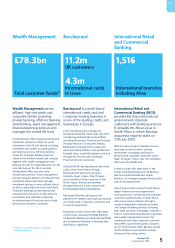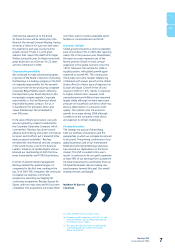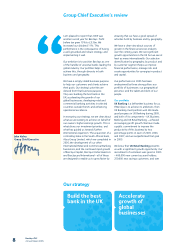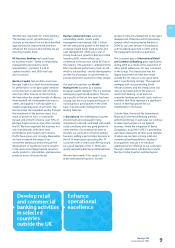Barclays 2005 Annual Report Download - page 15
Download and view the complete annual report
Please find page 15 of the 2005 Barclays annual report below. You can navigate through the pages in the report by either clicking on the pages listed below, or by using the keyword search tool below to find specific information within the annual report.-
 1
1 -
 2
2 -
 3
3 -
 4
4 -
 5
5 -
 6
6 -
 7
7 -
 8
8 -
 9
9 -
 10
10 -
 11
11 -
 12
12 -
 13
13 -
 14
14 -
 15
15 -
 16
16 -
 17
17 -
 18
18 -
 19
19 -
 20
20 -
 21
21 -
 22
22 -
 23
23 -
 24
24 -
 25
25 -
 26
26 -
 27
27 -
 28
28 -
 29
29 -
 30
30 -
 31
31 -
 32
32 -
 33
33 -
 34
34 -
 35
35 -
 36
36 -
 37
37 -
 38
38 -
 39
39 -
 40
40 -
 41
41 -
 42
42 -
 43
43 -
 44
44 -
 45
45 -
 46
46 -
 47
47 -
 48
48 -
 49
49 -
 50
50 -
 51
51 -
 52
52 -
 53
53 -
 54
54 -
 55
55 -
 56
56 -
 57
57 -
 58
58 -
 59
59 -
 60
60 -
 61
61 -
 62
62 -
 63
63 -
 64
64 -
 65
65 -
 66
66 -
 67
67 -
 68
68 -
 69
69 -
 70
70 -
 71
71 -
 72
72 -
 73
73 -
 74
74 -
 75
75 -
 76
76 -
 77
77 -
 78
78 -
 79
79 -
 80
80 -
 81
81 -
 82
82 -
 83
83 -
 84
84 -
 85
85 -
 86
86 -
 87
87 -
 88
88 -
 89
89 -
 90
90 -
 91
91 -
 92
92 -
 93
93 -
 94
94 -
 95
95 -
 96
96 -
 97
97 -
 98
98 -
 99
99 -
 100
100 -
 101
101 -
 102
102 -
 103
103 -
 104
104 -
 105
105 -
 106
106 -
 107
107 -
 108
108 -
 109
109 -
 110
110 -
 111
111 -
 112
112 -
 113
113 -
 114
114 -
 115
115 -
 116
116 -
 117
117 -
 118
118 -
 119
119 -
 120
120 -
 121
121 -
 122
122 -
 123
123 -
 124
124 -
 125
125 -
 126
126 -
 127
127 -
 128
128 -
 129
129 -
 130
130 -
 131
131 -
 132
132 -
 133
133 -
 134
134 -
 135
135 -
 136
136 -
 137
137 -
 138
138 -
 139
139 -
 140
140 -
 141
141 -
 142
142 -
 143
143 -
 144
144 -
 145
145 -
 146
146 -
 147
147 -
 148
148 -
 149
149 -
 150
150 -
 151
151 -
 152
152 -
 153
153 -
 154
154 -
 155
155 -
 156
156 -
 157
157 -
 158
158 -
 159
159 -
 160
160 -
 161
161 -
 162
162 -
 163
163 -
 164
164 -
 165
165 -
 166
166 -
 167
167 -
 168
168 -
 169
169 -
 170
170 -
 171
171 -
 172
172 -
 173
173 -
 174
174 -
 175
175 -
 176
176 -
 177
177 -
 178
178 -
 179
179 -
 180
180 -
 181
181 -
 182
182 -
 183
183 -
 184
184 -
 185
185 -
 186
186 -
 187
187 -
 188
188 -
 189
189 -
 190
190 -
 191
191 -
 192
192 -
 193
193 -
 194
194 -
 195
195 -
 196
196 -
 197
197 -
 198
198 -
 199
199 -
 200
200 -
 201
201 -
 202
202 -
 203
203 -
 204
204 -
 205
205 -
 206
206 -
 207
207 -
 208
208 -
 209
209 -
 210
210 -
 211
211 -
 212
212 -
 213
213 -
 214
214 -
 215
215 -
 216
216 -
 217
217 -
 218
218 -
 219
219 -
 220
220 -
 221
221 -
 222
222 -
 223
223 -
 224
224 -
 225
225 -
 226
226 -
 227
227 -
 228
228 -
 229
229 -
 230
230 -
 231
231 -
 232
232 -
 233
233 -
 234
234 -
 235
235 -
 236
236 -
 237
237 -
 238
238 -
 239
239 -
 240
240 -
 241
241 -
 242
242 -
 243
243 -
 244
244 -
 245
245 -
 246
246 -
 247
247 -
 248
248 -
 249
249 -
 250
250 -
 251
251 -
 252
252 -
 253
253 -
 254
254 -
 255
255 -
 256
256 -
 257
257 -
 258
258 -
 259
259 -
 260
260 -
 261
261 -
 262
262 -
 263
263 -
 264
264 -
 265
265 -
 266
266 -
 267
267 -
 268
268 -
 269
269 -
 270
270 -
 271
271 -
 272
272 -
 273
273 -
 274
274 -
 275
275 -
 276
276 -
 277
277 -
 278
278 -
 279
279 -
 280
280 -
 281
281 -
 282
282 -
 283
283 -
 284
284 -
 285
285 -
 286
286 -
 287
287 -
 288
288 -
 289
289 -
 290
290 -
 291
291 -
 292
292 -
 293
293 -
 294
294 -
 295
295 -
 296
296 -
 297
297 -
 298
298 -
 299
299 -
 300
300 -
 301
301 -
 302
302 -
 303
303 -
 304
304 -
 305
305 -
 306
306 -
 307
307 -
 308
308 -
 309
309 -
 310
310 -
 311
311 -
 312
312 -
 313
313 -
 314
314 -
 315
315 -
 316
316 -
 317
317 -
 318
318 -
 319
319 -
 320
320
 |
 |

changes is pervasive throughout these
results. At Group level, whilst individual line
items may have been significantly affected,
we believe the application of IAS 32, IAS 39
and IFRS 4 has not had a material impact on
attributable profits or earnings per share but
has significantly increased balance sheet
footings. We have previously reported in
detail on the line items which would be
affected by IFRS and the outcomes have been
consistent with our earlier expectations.
Capital strength
Our strong credit rating and disciplined
approach to capital management remain
sources of competitive advantage.
Our capital management policies are
designed to optimise the returns to
shareholders whilst maintaining our rating.
At the end of 2005, our tier 1 capital ratio
was 7.0% and our risk asset ratio was 11.3%.
Over the past two years we have consciously
sought to address the extent to which we
are carrying surplus capital and to use our
resources more intensively. In 2004, we
bought back approximately £700m in shares
and we have changed the mix of our core
capital in both 2004 and 2005 by introducing
preference shares into the capital base.
In 2005, we acquired Absa Group Limited
without issuing ordinary equity, made a
number of other smaller acquisitions,
increased weighted risk assets 10%
excluding Absa and paid dividends of £1.6bn.
Despite this we ended the year with a tier 1
ratio only marginally changed from the level
post the impact of IFRS at the beginning of
the year. This resulted from the strong cash
flow generation of our business portfolio and
the efficient management of the balance
sheet through the use of the capital markets.
(a) Economic profit is defined on page 7.
(b) Total income net of insurance claims.
(c) Profit before tax.
(d) Operating expenses compared to total
income net of insurance claims.
(e) Absa has changed its financial year end to
31st December to conform with Barclays.
The comparable period comprises unaudited
results for the nine months ended
31st December 2004.
(f) Does not reflect the application of IAS 32,
IAS 39 and IFRS 4 which became effective
from 1st January 2005. Further explanation
is provided on page 134.
Barclays PLC
Annual Report 2005 13
1.4
During 2006 we expect continued strong
growth in capital investment in our
businesses to support organic growth and for
our tier 1 capital ratio to move towards our
target of 7.25% through the combination of
the impact of retained earnings and
continued efficient use of the capital markets.
Outlook
We expect the UK economy to show
reasonable growth in 2006, but the credit
environment in the consumer sector is likely
to remain challenging. Impairment charges
in the UK small and medium business sector
have been exceptionally low in the recent
past and may trend towards more normal
levels in 2006. The healthy global economy
should provide a positive backdrop for all our
businesses this year. We start 2006 with
strong income momentum throughout
Barclays and this positions us well for
another year of good earnings growth.
Naguib Kheraj
Group Finance Director
”
